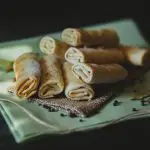If you’ve ever wondered what wool crepe fabric is and how it’s made, look no further. This article will provide you with all the essential information you need about this versatile material.
From its unique characteristics to its historical significance, you’ll gain a deeper understanding of wool crepe fabric.
Discover its various uses and applications, as well as how to properly care for it.
By the end, you’ll have a clear picture of what sets wool crepe fabric apart from other textiles.
Table of Contents
Characteristics of Wool Crepe Fabric
Wool crepe fabric is known for its lightweight and textured feel, making it perfect for creating elegant and flowing garments. This fabric is made from wool fibers that are tightly twisted and woven, resulting in a fabric with a subtle grainy texture.
One of the main advantages of wool crepe fabric is its ability to drape beautifully. The lightweight nature of the fabric allows it to fall gracefully, creating a flattering silhouette. Additionally, the textured surface adds visual interest to the garment, giving it a unique and luxurious look.
Another advantage of wool crepe fabric is its breathability. Wool fibers have natural properties that allow air to circulate, keeping the wearer cool and comfortable. This makes it an ideal choice for garments that are worn in warmer weather or in climates with high humidity.
However, there are also some disadvantages to consider when using wool crepe fabric. One of the main disadvantages is its tendency to wrinkle easily. This can be a challenge when it comes to maintaining the garment’s appearance, as creases and wrinkles can be difficult to remove.
Overall, wool crepe fabric offers many advantages, such as its lightweight and textured feel, as well as its breathability. However, it is important to be mindful of its tendency to wrinkle easily.
History of Wool Crepe Fabric
You’ll be intrigued to learn that the origins of this remarkable textile can be traced back to ancient civilizations. Wool crepe fabric has a rich history that has evolved over time. Here are some key points about the evolution and popularity of wool crepe fabric:
-
Early Origins: Wool crepe fabric has been around for centuries, with its roots dating back to ancient civilizations such as Egypt and Mesopotamia. It was known for its versatility, durability, and ability to retain heat, making it ideal for cold climates.
-
Industrial Revolution: The popularity of wool crepe fabric soared during the Industrial Revolution. The development of new machinery allowed for faster and more efficient production, making wool crepe fabric more accessible to the masses.
-
Modern Innovations: Over the years, wool crepe fabric has undergone various innovations to enhance its qualities. Today, it is often blended with synthetic fibers to improve its drape, resilience, and wrinkle resistance.
-
Fashion Industry: Wool crepe fabric has remained a staple in the fashion industry due to its unique texture and versatility. It is commonly used in the creation of elegant dresses, skirts, and tailored suits, thanks to its ability to hold its shape and create beautiful drapes.
The evolution of wool crepe fabric and its continued popularity in the fashion industry showcases its enduring appeal and timeless charm.
Uses and Applications of Wool Crepe Fabric
When it comes to fashion, you can’t go wrong with the versatility and elegance of wool crepe fabric. This remarkable textile is widely used in various applications, thanks to its unique properties. Let’s take a closer look at the advantages and disadvantages of wool crepe fabric.
| Advantages | Disadvantages |
|---|---|
| Luxurious and elegant appearance | Prone to shrinking if not properly cared for |
| Excellent drape and flow | Can be expensive compared to other fabrics |
| Wrinkle-resistant | Requires special care and cleaning methods |
One of the key advantages of wool crepe fabric is its luxurious and elegant appearance. It adds a touch of sophistication to any outfit, making it a popular choice for formal wear and high-end fashion. Additionally, wool crepe fabric has excellent drape and flow, allowing it to create flattering silhouettes and enhance the wearer’s figure.
Another advantage of wool crepe fabric is its wrinkle-resistant nature. This makes it an ideal choice for garments that need to maintain their shape and look polished throughout the day.
However, it’s important to note that wool crepe fabric does have a few disadvantages. It can be prone to shrinking if not properly cared for, so it’s essential to follow the manufacturer’s instructions for cleaning and maintenance. Additionally, wool crepe fabric can be more expensive compared to other fabrics, which may limit its accessibility to some consumers. Overall, the advantages of wool crepe fabric outweigh its disadvantages, making it a popular choice among fashion enthusiasts.
How Wool Crepe Fabric Is Made
The process of making wool crepe involves weaving and then treating the fabric to create its unique texture and properties.
In the manufacturing process of wool crepe fabric, the first step is to weave the yarns together. This weaving technique creates a tight and twisted pattern that gives the fabric its signature crinkled texture.
Once woven, the fabric is then treated through a process called fulling. Fulling involves subjecting the fabric to heat, moisture, and friction, which causes the fibers to bond and shrink. This results in the fabric becoming denser, more durable, and resistant to wrinkles.
Wool crepe fabric has several properties and benefits that make it a popular choice in the fashion industry.
The crinkled texture of the fabric gives it a unique drape and elasticity, allowing it to stretch and conform to the body. This makes it comfortable to wear and ideal for garments that require movement, such as skirts and dresses.
Additionally, wool crepe has excellent insulation properties, making it suitable for both warm and cold weather. The fabric is also naturally breathable, wicking away moisture and keeping the wearer dry.
Furthermore, wool crepe is known for its durability, resistance to pilling, and ability to retain its shape even after multiple washes.
Overall, the manufacturing process and properties of wool crepe fabric make it a versatile and desirable fabric for various clothing applications.
Care and Maintenance of Wool Crepe Fabric
To keep your wool crepe garments in good condition, it’s important to follow the care instructions provided by the manufacturer.
When it comes to washing wool crepe, it’s best to hand wash it in cold water using a mild detergent. Avoid using harsh chemicals or bleach, as they can damage the fabric. Gently agitate the garment in the water, and then rinse it thoroughly.
After washing, carefully squeeze out the excess water, but do not wring or twist the fabric. Instead, lay it flat on a clean towel and roll it up to remove any remaining water.
When it comes to drying, avoid direct sunlight or heat sources, as they can cause the fabric to shrink or lose its shape. Instead, let it air dry on a flat surface.
When storing your wool crepe garments, make sure they are clean and dry. Fold them neatly and store them in a cool, dry place, away from direct sunlight and moisture.
Following these washing techniques and storing tips will help prolong the life of your wool crepe garments and keep them looking their best.
Differences Between Wool Crepe and Other Fabrics
You can easily distinguish wool crepe from other fabrics by its unique texture and drape. Here are some key characteristics that set wool crepe apart:
- Wool crepe has a crisp and slightly rough texture, which gives it a distinct tactile feel compared to other fabrics.
- It has a natural elasticity that allows it to drape beautifully, making it ideal for creating flowing garments with a graceful silhouette.
- Wool crepe has a matte finish, giving it a more subdued and sophisticated look compared to fabrics with a shiny or glossy appearance.
Advantages of wool crepe fabric include its durability, as it is known for being long-lasting and resistant to wear and tear. It also has excellent breathability, making it comfortable to wear in a variety of climates.
On the downside, wool crepe can be prone to shrinking if not properly cared for, and it may require professional dry cleaning to maintain its shape and texture. Additionally, some people may find wool crepe to be slightly scratchy or itchy against their skin, so it is important to consider personal comfort levels when choosing this fabric.
Conclusion
In conclusion, wool crepe fabric is a versatile material with unique characteristics. It has a textured surface, drapes well, and is known for its resilience and durability.
This fabric has a long history and is used in various applications including clothing, upholstery, and crafts.
Understanding how wool crepe fabric is made and properly caring for it will ensure its longevity.
Overall, wool crepe fabric stands out among other fabrics for its distinct qualities and wide range of uses.
- Tetron Fabric for Marine Applications: Durability and Use Cases - June 18, 2025
- Tetron Fabric for Outdoor Furniture: Weather Resistance and Care - June 18, 2025
- Tetron Fabric for Wall Coverings: Style and Application Tips - June 18, 2025



